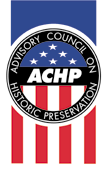 About ACHP
About ACHP ACHP News
National Historic
Preservation
Program
Working with
Section 106
Federal, State, & Tribal Programs
Training & Education
Publications
Search
Home
Senior Policy Officials Discuss Needs Under Section 3
 |
| Participating in the square table discussion at the Senior Policy Official meeting Feb. 21 are from left, Clay Johnson, III (OMB), John L. Nau, III (ACHP), Cherie Harder (White House), John Fowler (ACHP), and David Winstead (GSA). |
Advisory Council on Historic Preservation (ACHP) Chairman John Nau hosted a meeting of Senior Policy Officials Feb. 21 to discuss the findings and recommendations made in the ACHP’s 2006 Section 3 report. It offered the officials a chance to engage in a square table discussion about how the ACHP might address these recommendations.
Senior Policy Officials (SPOs) are those individuals designated under Executive Order 13287, “Preserve America,” who have policy oversight responsibility for their federal agency’s historic preservation program. This was the first such meeting since the ACHP submitted The Preserve America Executive Order Report to the President in February 2006, per Section 3(c) of Executive Order (EO) 13287.
Section 3 of EO 13287 requires real property managing agencies to submit a triennial report on their progress in identifying, protecting, and using historic properties in its ownership. Agencies submitted baseline reports in 2004 and progress reports in 2005. The ACHP review of these reports resulted in the ACHP making six findings on the current status of the federal historic preservation program as a whole, along with recommendations for addressing each finding. Through the dialogue at the Preserve America Summit in 2006 and with federal agencies over the last year, it has become clear there are four thematic areas found in the 2006 recommendations to the President: (1) Enhancing and Improving our Inventory of Historic Properties; (2) Integrating Stewardship into Agency Planning; (3) Building Partnerships; and (4) Managing Our Assets.
The SPO meeting began with opening remarks from Cherie Harder, special assistant to the President and First Lady, on behalf of First Lady Laura Bush who is honorary chair of the Preserve America initiative. Deputy Secretary of the Department of the Interior Lynn Scarlett and Deputy Director for Management Clay Johnson, III, of the Office of Management and Budget also spoke to the group. In the meeting, the ACHP heard from participating agencies about their experiences in implementing EO 13287 and both the successes and challenges they face in improving their preservation programs.
Several important topics addressed by participants are highlighted below:
- Federal agencies are working hard to improve their inventory of real property. As noted in the ACHP Report to the President, agencies have made significant progress in reporting on their historic properties as assets in real property management portfolios and in identifying opportunities to integrate varying federal reporting requirements. However, discussion during the meeting also showed agencies face a variety of challenges in ensuring their efforts to inventory historic properties contribute to the broader goals of states, tribes, and local governments in developing a national inventory as suggested during the Preserve America Summit.
- Many of the SPOs acknowledged they lack useful business models to demonstrate the economic value of historic properties in an agency’s portfolio. The discussion demonstrated that all agencies would benefit from the use of such models, even for properties that should not or will not be managed solely for their economic value. Several agencies offered to share business models that have been useful in their efforts to achieve these goals.
- Participants heard that the General Services Administration (GSA) has effectively used Section 111 of the National Historic Preservation Act to lease properties and can demonstrate to other federal agencies how Section 111 can become a tool in their overall asset management toolbox.
The ACHP anticipates federal agencies having important progress to report on in 2008 as agencies constantly improve their ability to integrate historic property information into the various federal reporting requirements. Toward that end, the ACHP has pledged to reconvene its EO 13287 Advisory Guidelines Working Group (first activated in 2003 to produce the initial Section 3 guidelines for federal agencies) and work closely with partner agencies to develop guidance for the 2008 reports. The Office of Federal Agency Programs has committed to issuing these guidelines by summer 2007. The ACHP will ensure these efforts complement the overall goals of the Preserve America initiative and that commitments are incorporated into the ACHP strategic plan.
For additional information on the role of Senior Policy Officials and Section 3 reporting please contact Reid Nelson, assistant director, at (202) 606-8556 or rnelson@achp.gov.